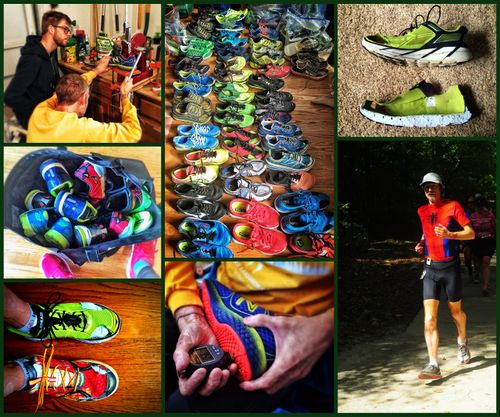How I Test Running Shoes
Revision as of 08:24, 1 January 2015 by User:Fellrnr (User talk:Fellrnr | contribs)
Revision as of 08:24, 1 January 2015 by User:Fellrnr (User talk:Fellrnr | contribs)

Clockwise from top left: Measuring compression and cushioning. Part of my shoe collection. A dissected shoe. A 50 mile run in the Altra One2. Measuring shoe hardness. Running in Odd Shoes (injury risk!). My bag of shoes I take to my runs so I can swap between them during the runs.
Testing shoes is a combination of art and science. I apply as much of The Science of Running Shoes as is possible, backed up with tens of thousands of miles of running experience. Because different runners look for different compromises in their shoes, may provide recommendations for different categories. Some runners like a minimalist shoe, others the massively cushioned Minimax style, while others prefer a shoe that improves their performance. I test shoes in a variety of ways:
- Running. The obvious way to test a shoe is simply to run in it, but while this can be effective, I've found few insights this way (other than the "bleedin' obvious").
- Long Runs. Running for longer distances in a shoe can reveal its strengths and weaknesses in a way that shorter runs overlook. I've found some useful insight from runs between 16 and 100 miles long, where small problems can become magnified.
- Contrast Runs. Because our senses are good at detecting change, but quickly adapt to the situation is "normal", I found it valuable to swap between shoes during a run. Care must be taken using this technique is a cold shoe feels quite different to one that is warmed up, but swapping back and forth between two similar shoes quickly highlights the differences.
- Odd Shoes. A more extreme version of this contrast approach is to wear a different shoe on each foot. This is a wonderful way of highlighting the differences, but it entails a significant injury risk, so caution is required.
- Metrics. I like to back up my subjective analysis with some objective measurements.
- Weight. This is an easy one using a scale.
- Height & Drop. Measuring the height of the sole is not as easy as it seems because you have to decide where to measure from. I measure from under the ball of the foot for the forefoot measurement and under the ball of the heel for rear foot. The difference is the drop, but I also measure again with weight in the shoe to find out a more realistic value is for the drop.
- Flexibility. It's reasonably easy to measure the force it takes to bend a shoe, but the way a shoe bends may not match how your foot moves, so there is some subjectivity in this measurement.
- Cushioning. Measuring the cushioning is surprisingly complex, as it includes both static and dynamic behaviors. I've found the standard approaches to measuring cushioning do not seem to reflect the perceived cushioning, so I've spent time developing my own equipment and techniques.
- Cold Cushioning. I've started to look at the cushioning that a shoe provides when it's been in a freezer (~10f/-10c).
- Dissection. I find it useful to dissect some of the shoes to reveal their inner construction. I don't do this all the shoes due to the cost. (I buy all my shoes through normal retail outlets, so these reviews are expensive to produce.)